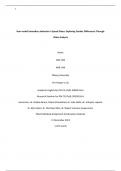Essay
Individual assignment: Contrastive analysis Research Seminar
- Instelling
- Tilburg University (UVT)
This document can be used for the individual assignment for Research Seminar and Academic English during the Pre-master's program of Communication & Information Sciences.
[Meer zien]




